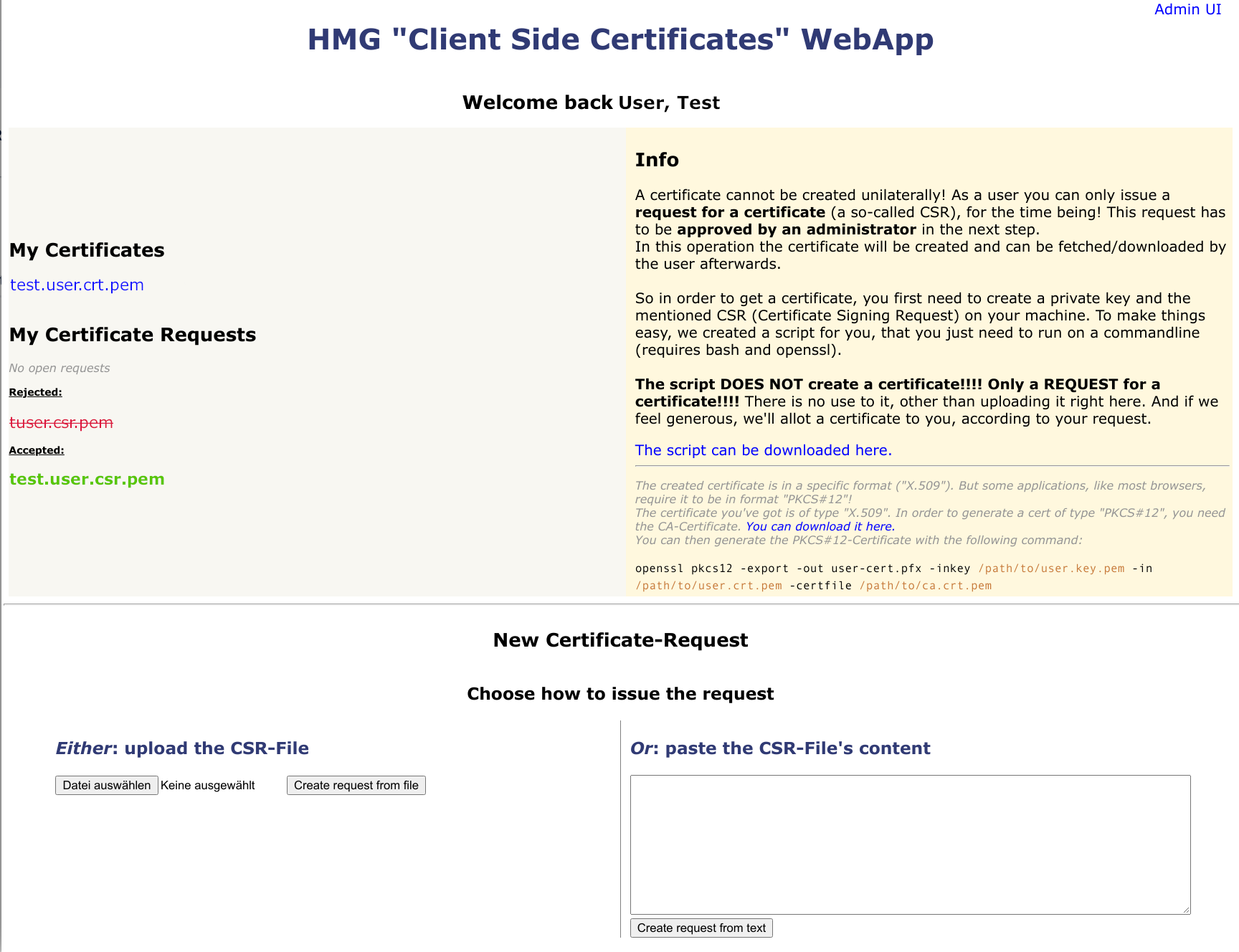Having an IP-Whitelist in order to manage access to your internal Services/Website, is a somewhat dated concept. And it comes with several issues. Like: what about developers in home-office?
But authentication via certificates is of course more complicated. Especially for the users! The reason is, that they just want to access the service, and for all what they know, this usually involves entering a username and password. But with certificates one can do so much more - and its necessary to hide this complexity, and make using them as easy as possible.
Now, when you search around the internet for "certificate management" or the like, you'll find a bunch of software, that makes things more complicated, rather than less.
The app should enable the user to get, or at least request, a persona certificate with as few actions as possible. On the administrative side, there shall be an overview of the pending requests as well as the already signed one. Signing a request shall be as easy as "enter a password and push the button"! All actions (signing, revocation...) should be versioned - so it suggests itself to use git, to store the certificates and other data.
- In order for a user to requests a certificate, it must be ensured, that the user is authenticated - meaning, its identity must be verified!
- You may also want to make sure, that the identified user is indeed authorized to request a new certificate!
- It must be easy for the user to create a CSR (Certificate Signing Request) - a script with some sane defaults seem appropriate.
- The user must be able to just upload the CSR
- Downloading the certificate - once it has been signed - must be similarly easy.
- If the Request has been rejected, the user must be able to notice that.
- There must be a description, how to get the certificate into the browser of the user.
- Pending request must be listed on the admin-page (with details)
- Signed requests must be listed on the admin-page
- Certificates and the whole openssl-stuff shall be stored in a git-repository
- It must be possible to encrypt the data, to avoid having plain-text data about the users in the git-repository
The app does not setup the openssl-repository for you - see below, how to achieve that.
Spring-Boot is used as framework. Authentication is done using spring-security-oauth2 combined with azure-spring-boot - so an Azure AD is required.
The application runs happily in a docker-container within AKS (Azure Kubernetes Service).
Most openssl-actions are done by invoking the native command - because its more simply (and thus also more robust and secure) and reliable than using some library that might also lack some required features.
The current implementation will always encrypt the important files (like cert, csr, keys) before committing them (and decrypt after checkout). In order to avoid trouble with git, it always uses the same (configurable) salt - otherwise git would always assume all encrypted files as changed!
The Dockerfile assume the custom configuration to be located at /opt/config/application.properties.
You (may) need to configure at least the following properties in that file and replace the values for your needs:
data.cert-repo=ssh://git@your.git/cert/repository.git
data.git-user-keyfile=/opt/config/ci-user-ssh.key
data.cert-revocation-list-path=/data/shared/crl.list
data.notification-sender=_REPLACEME_
spring.mail.host=_REPLACEME_
spring.mail.port=587
spring.mail.username=_REPLACEME_
spring.mail.properties.mail.smtp.starttls.enable=true
spring.mail.properties.mail.debug=false
azure.activedirectory.tenant-id=00000000-0000-0000-0000-000000000000
azure.activedirectory.user-group.allowed-groups=group1, group2, group3
#azure.activedirectory.client-id=00000000-0000-0000-0000-000000000000
#azure.activedirectory.client-secret=#{pki-web-aad-client-secret}#
azure.activedirectory.authority=https://login.microsoftonline.com/00000000-0000-0000-0000-000000000000/Optional properties:
# if running behind a reverse-proxy:
server.use-forward-headers=true
data.crypt-salt=<HEX-SALT>For a good explanation - and more important: good configuration examples - of the following commands, you might want to read the following guide: https://jamielinux.com/docs/openssl-certificate-authority/index.html
Create a proper named git-repository (e.g. client-side-certs) and check it out.
cd into the repository.
Make sure to have proper configurations at hand! (If not: read the above linked guide first!)
###
# create basics and ca-cert
mkdir certs crl newcerts private
touch index.txt
echo 1000 > serial
openssl genrsa -aes256 -out private/ca.key.pem 4096
# store the password in a key-vault of your choice
# 7300 / 365 = 20
openssl req -config openssl.cnf -key private/ca.key.pem -new -x509 -days 7300 -sha256 -extensions v3_ca -out certs/ca.cert.pem
###
# create intermediate cert
mkdir intermediate
cd intermediate
mkdir certs crl csr newcerts private
touch index.txt
echo 1000 > serial
echo 1000 > crlnumber
openssl genrsa -aes256 -out intermediate/private/intermediate.key.pem 4096
openssl req -config intermediate/openssl.cnf -new -sha256 -key intermediate/private/intermediate.key.pem -out intermediate/csr/intermediate.csr.pem
# sign intermediate CSR
openssl ca -config openssl.cnf -extensions v3_intermediate_ca -days 3650 -notext -md sha256 -in intermediate/csr/intermediate.csr.pem -out intermediate/certs/intermediate.cert.pem
openssl verify -CAfile certs/ca.cert.pem intermediate/certs/intermediate.cert.pem
cat intermediate/certs/intermediate.cert.pem certs/ca.cert.pem > intermediate/certs/ca-chain.cert.pem
###
# create CRL (certificate revocation list)
openssl ca -config intermediate/openssl.cnf -gencrl -out intermediate/crl/intermediate.crl.pem
